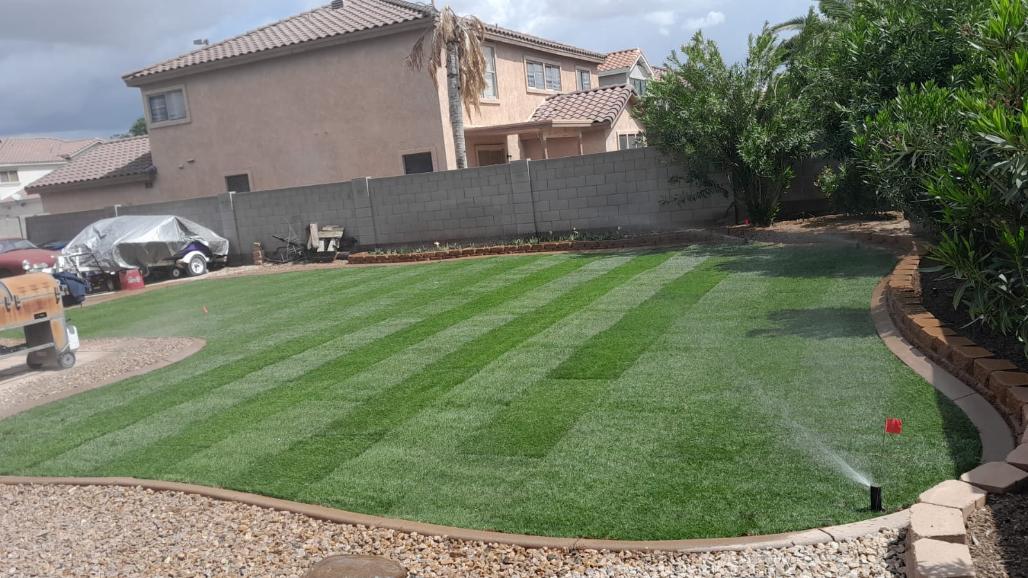How to take care of your lawn!
1. Watering: Water your new lawn regularly and deeply, keeping the soil moist but not waterlogged. Typically, it’s recommended to water newly installed lawns 2-3 times a day for the first week, then gradually reduce the frequency as the roots establish, eventually watering once a week.
2. Mowing: Wait until the grass is at least 3 inches tall before mowing. When you do mow, set the mower blades high (about 2 to 3 inches) and avoid cutting off more than one-third of the blade length at a
3. Weeding: Keep an eye out for weeds and remove them promptly by hand or with a herbicide that’s labeled for use on new lawns.
4. Aerating: Over time, soil can become compacted, which can make it difficult for grass roots to grow. Aeration, which involves poking small holes in the soil, can help to loosen the soil and allow water and nutrients to penetrate deeper.
6. Protection: Avoid heavy foot traffic on your new lawn for the first few weeks, and keep pets and children off of it if possible, to give the roots a chance to establish.

For Any Other Questions Regarding Lawn Care or Maintenance
Call 1+ (602) 524-0770
FAQ’s of Lawn Care
What are the advantages of sod vs. seed?
Answer: Sod provides an instant, mature lawn appearance, while seed requires time to grow. Sod also establishes quicker, reducing soil erosion and weeds.
I am renovating my lawn. How do I remove the old grass?
Answer: You can remove old grass by either hand digging or using a sod cutter. Ensure you remove all roots and debris to prepare the area for new sod or seed.
How deep should I till the soil in the installation area?
Answer: Tilling the soil to a depth of 4-6 inches allows for proper root penetration and ensures good drainage and nutrient absorption for healthy lawn growth.
When should I fertilize?
Answer: Fertilize your lawn in the early spring and late fall for cool-season grasses, and in late spring for warm-season grasses. Follow recommended application rates for optimal results.
How much water does newly laid sod require?
Answer: Newly laid sod needs frequent watering to establish roots. Water daily for the first 1-2 weeks, keeping the soil consistently moist but not waterlogged.
When should I mow for the first time?
Answer: Wait until the sod has rooted firmly, typically 10-14 days after installation, before mowing. Set the mower blade to a height that removes no more than 1/3 of the grass height.
Is there a grass in Arizona that will stay green all year long?
Answer: Yes, Bermuda grass is a warm-season grass commonly used in Arizona that stays green year-round with proper maintenance.
Is there a grass that will grow in the shade?
Answer: Yes, St. Augustine grass and fine fescue are suitable options for shady areas. They tolerate low light conditions better than other grass varieties.
I have kids and dogs. What is the most durable for high traffic areas?
Answer: Bermuda grass and Zoysia grass are both highly durable and resilient to heavy foot traffic, making them ideal choices for lawns with kids and pets.
What is the best way to transition from a winter lawn to a summer lawn?
Answer: Transition gradually by reducing water and allowing the winter grass to naturally fade as temperatures rise. Overseeding with warm-season grasses can help fill in bare patches.
What is the difference between Sod and Turf?
Answer: Sod refers to rolls or pieces of mature grass that are cultivated and grown on a specialized farm. It consists of a layer of grass plants, along with their root systems and a thin layer of soil, all held together by a mesh of roots or a biodegradable material. Sod is typically installed on prepared soil to quickly establish a lush and mature lawn. It provides an instant and consistent grass cover, making it a popular choice for quickly transforming a bare or damaged area into a green and usable space.Artificial turf, also known as synthetic turf or fake grass, is a man-made surface designed to replicate the appearance and function of natural grass. It is primarily used in landscaping, sports fields, playgrounds, and other recreational areas where a natural grass surface may be impractical or challenging to maintain. Artificial turf has gained popularity due to its low maintenance requirements and durability.
FAQ’s of Landscaping
How do I start planning my landscape design?
Answer: Start by assessing your property’s needs, considering your preferences and budget, and identifying the purpose of different areas. Sketch out a rough layout, choose plant materials, hardscape elements, and other features that suit your vision. You may also consider consulting a professional landscape designer for guidance.
What are hardscapes and softscapes?
Answer: Hardscapes refer to the non-living elements in a landscape design, such as paths, walls, and structures. Softscapes, on the other hand, encompass the living elements like plants, trees, and grass. Together, they create a harmonious balance in outdoor spaces.
What is xeriscaping?
Answer: Xeriscaping is a landscaping approach that focuses on conserving water by using drought-resistant plants, efficient irrigation systems, mulching, and other water-saving techniques. It’s particularly useful in arid or water-scarce regions.
How do I choose the right plants for my landscape?
Answer: Consider factors like your climate zone, soil type, sunlight exposure, and maintenance preferences. Select plants that thrive in your area and complement the overall design theme. Mixing various plant types ensures year-round interest and reduces the risk of disease or pest problems.
How often should I water my landscape plants?
Answer: Watering frequency depends on factors like plant type, soil conditions, weather, and the time of year. Generally, it’s better to water deeply and less frequently to encourage deeper root growth. A soaker hose or drip irrigation system can help deliver water directly to the root zone.
What are some low-maintenance landscaping ideas?
Answer: Consider using native plants that are adapted to your region’s climate and require less care. Minimize the use of high-maintenance features like large lawns. Install mulch to suppress weeds, retain moisture, and improve soil health. Incorporate automated irrigation systems for efficient watering.
How can I control weeds in my landscape?
Answer: Regularly mulching your beds can help prevent weed growth by blocking sunlight and reducing soil moisture. Hand-pulling weeds before they go to seed is also effective. For persistent weeds, consider using organic or chemical herbicides as a last resort.
What is the difference in Pavers and travertine?
Answer: Pavers are a type of manufactured paving stone commonly used in outdoor applications like patios, walkways, driveways, and pool decks. They are made from various materials, including concrete, clay, and natural stone. Concrete pavers are the most common and widely used type.Travertine is a type of natural stone often used in outdoor landscaping and hardscaping projects. It’s known for its unique appearance, durability, and elegant look. Travertine is a form of limestone that has been subjected to heat and pressure, resulting in its distinct texture.
What is curbing?
Answer: Curbing, also known as landscape curbing or landscape edging, refers to the installation of a physical border or barrier along the edges of landscaping elements such as flower beds, pathways, driveways, and lawns. The primary purpose of curbing is to create a clear separation between different areas in a landscape while providing functional, aesthetic, and maintenance benefits.

